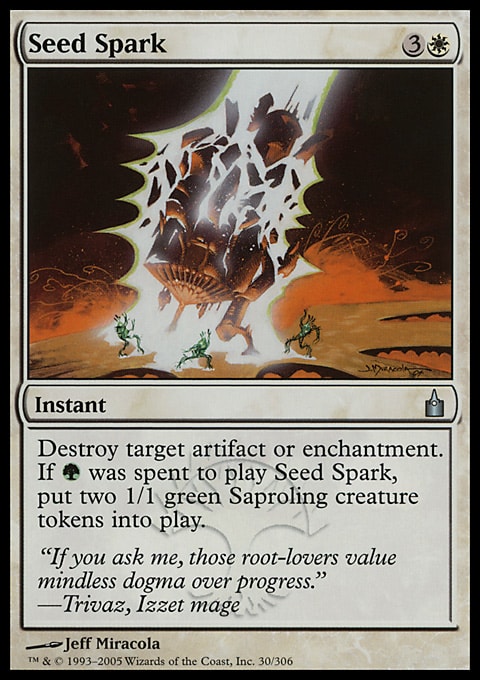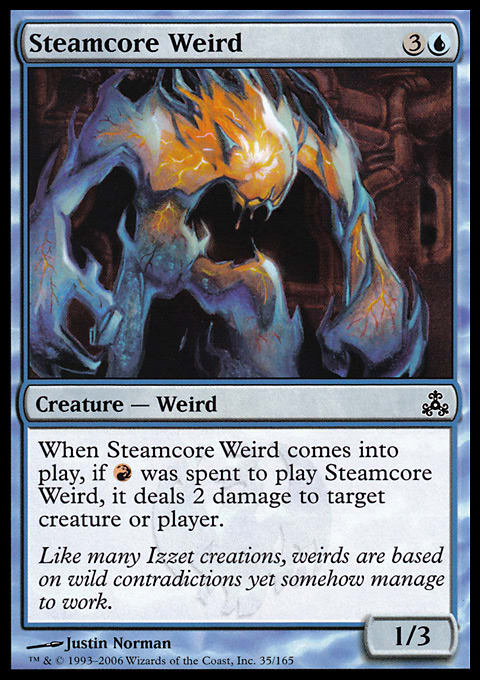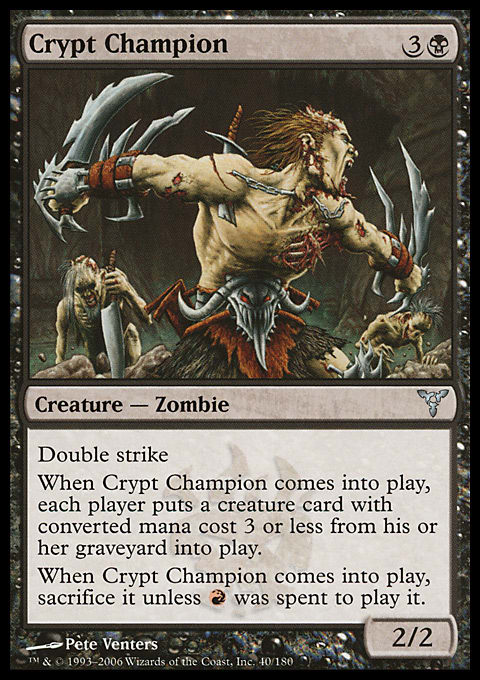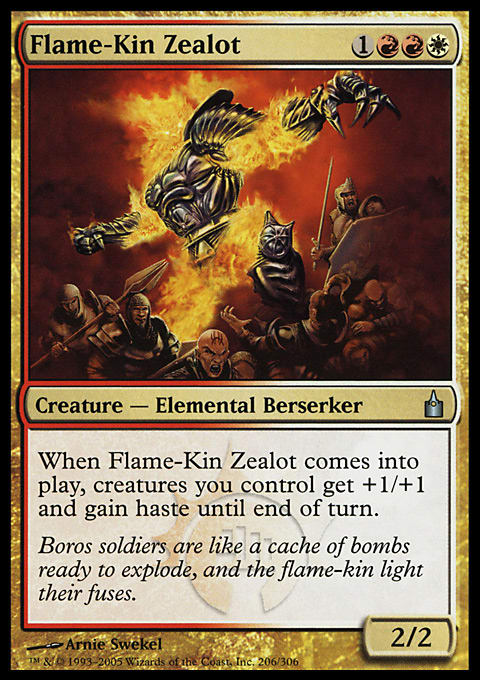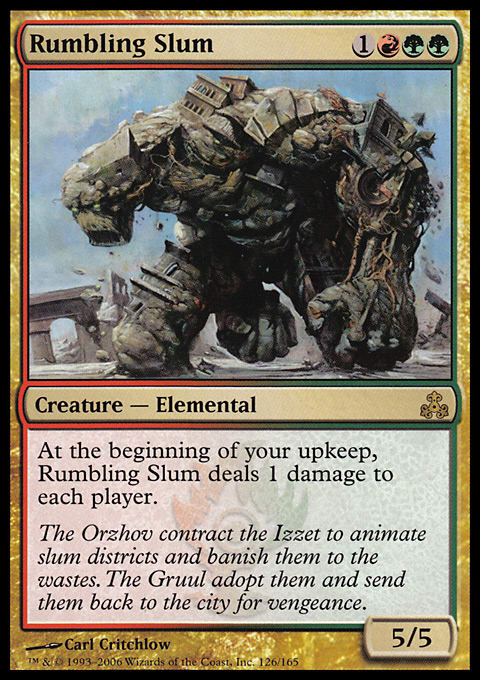Last week, I covered half the cycles of Ravnica: City of Guilds block. Title and context probably have informed you what I’m doing this week. If not, here’s the boilerplate (Darksteel Plate?) text about it:
- I’m looking at horizontal cycles (Titans), not vertical cycles (Penumbra Bobcat/Penumbra Kavu/Penumbra Wurm). They need at least five cards, though they don’t have to be in five colors.
- No all-common cycles. They tend to be boring.
- No land/mana cycles. They tend to be too similar for my purposes. Besides, every dual land is good.
I’m grading each cycle on three categories:
- Playability – Does this cycle have any cards people want to play?
- Depth – Was it hit-and-miss or strong overall?
- Resonance – Memorable cycles should be able to pass the flavor test, although some cycles are mechanical and are not intended to have shared flavor. Still, making all the cards cost the same, have similar names, or share other characteristics can make a cycle memorable when it otherwise wouldn’t be.
Not only did Ravnica block have the ten-card guild cycles most easily thought of, such as the Guildmages, but it also had some twenty-card cycles that had different characteristics within their sets. I’m guessing it’s difficult to design a twenty-card cycle, never mind explain it, so I’ve broken it up into the cycles as they were in their individual sets. By all standards, these make a cycle, but they’re normally not thought of this way—who’s going to remember all twenty? Here goes . . .
The “If Blah Was Spent to Play” Megacycle
Each set had mono-colored spells that powered up with a different color of mana in them. Seed Spark is white but powers up with ![]() , while Dryad's Caress is green but powers up with
, while Dryad's Caress is green but powers up with ![]() . Each set took this theme differently, so each set could be considered its own cycle, but the twenty cards go together, if loosely.
. Each set took this theme differently, so each set could be considered its own cycle, but the twenty cards go together, if loosely.
I’m giving a B in resonance to each iteration of the megacycle. They have some things to tie them together over being a strictly mechanical cycle, so it’s not a straight C, but there’s no flavor working for them.
Ravnica Edition
(Induce Paranoia, Ribbons of Night, Seed Spark, Dryad's Caress, Vigor Mortis, Rolling Spoil, Boros Fury-Shield, Flash Conscription)
Playability: B
Depth: A−
The most famous of these might be Seed Spark, a main deck inclusion in the GhaziGlare deck that won Worlds 2005. Seed Spark works in casual as well, as the Saprolings give back some depth normally lost by including artifact/enchantment removal. Boros Fury-Shield is a casual staple in its colors, one of the nastiest throwdowns against a huge creature. Almost every R/W deck I’ve ever made wants BF-S as its BFF.
The others all have their place; the combination of abilities normally determines their playability. I’m a fan of Vigor Mortis, and I’ve known fans of Flash Conscription. Induce Paranoia still works in Dimir mill decks, and Ribbons of Night is a little underrated. (My best friend always sang the card name to “Music of the Night” from Phantom of the Opera when casting it. Maybe that helps it be a better card.)
Guildpact Edition
(Tin Street Hooligan, Gruul Scrapper, Shrieking Grotesque, Revenant Patriarch, Steamcore Weird, Ogre Savant)
Playability: B
Depth: B−
The Guildpact version stuck the other-color abilities on enters-the-battlefield triggers of creatures, but the new group was underwhelming. Steamcore Weird and Ogre Savant were excellent in Limited, but they, like Gruul Scrapper and Shrieking Grotesque, are too small to be worth the creature. I’ve tried to use Revenant Patriarch in cool decks, but its inability to block is usually too high a drawback. Tin Street Hooligan was more or less Ancient Grudge: The Prequel (This Time, It Means Business) . Since the sweet spell effect was only available on casting, this group wasn’t great.
Dissension Edition
(Azorius Herald, Court Hussar, Crypt Champion, Squealing Devil, Plaxmanta, Patagia Viper)
Playability: B+
Depth: B+
This version—get the spell effect but sacrifice the creature if you didn’t spend the off-color mana—evokes evoke, ensuring the effect regardless of how the creature entered the battlefield. Squealing Devil rarely is great, but I have Patagia Viper and Crypt Champion in casual decks. The Viper puts out three creatures for 4 mana—Geist-Honored Monk lite—and the Crypt Champion’s double strike hits hard when pumped up by Zombie tribal lords. Crypt Champion is best known for its role in Project X with Saffi Eriksdotter. Although that sounds like a raunchy film with an Icelandic director (soundtrack by Bjork!), Project X was something like the Angel of Glory's Rise reanimator deck of its era, using an arbitrarily large number of enters-the-battlefield/death triggers for Essence Warden or Teysa, Orzhov Scion. That’s less about Crypt Champion’s awesomeness and more about its auto-death trigger, but it’s something anyway.
Court Hussar is an earlier Sea Gate Oracle, Plaxmanta remains one of the best Mizzium Skin–style effects, and Azorius Herald is a good deal. You’ll never wow anyone with this sextet, but it’s plenty useful, saving the megacycle creatures from being dragged down too far by Guildpact.
The CDD Megacycle
In card design/development terms, C and D are general colored mana costs. If you were designing multicolored 2-drops for each color combination, you’d refer to it as a cycle that cost CD. The twenty cards in this megacycle all have CDD in their mana costs: 1 mana of one color and 2 of another. This collection of uncommons and rares isn’t obviously a cycle, but each CDD combination has precisely one card in the block (with a curious exception), so it counts. Their awkwardly specific casting costs means the playable ones are well-remembered, while the iffy ones are well-forgotten (oxymoron?). Well done if you got all twenty at home.
I’m giving each part of the megacycle a C in resonance because it’s strictly mechanical.
Ravnica Edition
(Clutch of the Undercity, Mindleech Mass, Congregation at Dawn, Phytohydra, ?, Grave-Shell Scarab, Flame-Kin Zealot, Firemane Angel)
Playability: A−
Depth: B
There are several wonderful cards in this group. Congregation at Dawn and Clutch of the Undercity I’ve used the most, but Firemane Angel and Flame-Kin Zealot have been hits with others. Grave-Shell Scarab had a lot of hype but never found the right home; as with Ghost Council of Orzhova, taking damage off the stack hurts its current playability. Phytohydra’s amazing when you can flash it in; otherwise, it defies my efforts to make it awesome.
The ? is confusing. ![]()
![]()
![]() is the only combination in the megacycle to see two cards: Drooling Groodion and Woodwraith Corrupter. Whichever one you want to include is sadly underwhelming. Why they broke the rules to add Drooling Groodion, I’ll never know.
is the only combination in the megacycle to see two cards: Drooling Groodion and Woodwraith Corrupter. Whichever one you want to include is sadly underwhelming. Why they broke the rules to add Drooling Groodion, I’ll never know.
Guildpact Edition
(Skarrgan Skybreaker, Rumbling Slum, Souls of the Faultless, Culling Sun, Goblin Flectomancer, Invoke the Firemind)
Playability: B+
Depth: A−
I’ve seen all of these in games before; that’s gotta speak something to depth. Few Orzhov casual decks haven’t wanted what Souls of the Faultless has to offer. Rumbling Slum, the somewhat obsolete Culling Sun (Consume the Meek is mono-colored and instant; I play them both in my Tariel, Reckoner of Souls Commander deck), and Invoke the Firemind are or have been multiplayer hits, but none of them is as essential to basic guild function as Souls of the Faultless.
I’m a fan of Goblin Flectomancer; the toughest part about Swerve effects is leaving mana open for the trap, but the Flectomancer addresses that by being on the board and free to activate. It doesn’t belong in every deck that could cast it, but it will change a multiplayer game like nobody’s business.
There isn’t the upside of a Congregation at Dawn here, but every card here has fans. Guildpact probably put the best cards into the megacycle overall.
Dissension Edition
(Azorius Ploy, Swift Silence, Rakdos Augermage, Anthem of Rakdos, Voidslime, Omnibian)
Playability: A−
Depth: B+
I’m biased on playability by Voidslime, one of my favorite cards ever. But it’s a multiplayer gem if you have them. Nobody plays expecting their triggered abilities to be countered, and players rarely expect activated abilities to be countered either. I don’t like to leave a whole lot of mana open for tricks, but Voidslime is worth it.
Swift Silence normally isn’t worth it, but it has a specific role it fills perfectly. Azorius Ploy is a little pricey, but it can be a blowout. I rarely build decks that want the effect, but your decks might want it. Anthem of Rakdos is surprisingly easy to build around; doubling all your damage at hellbent, not just the attack-related damage of the first part of the rules text, is the key to working with it. Rakdos Augermage was an Invitational card, and for that reason, it’s considered a disappointment, but it’s right for certain decks. And then there’s Omnibian, who is obviously awesome even when you have no deck for it. All told, a fine group.
The Hybrid Rares
(Dovescape, Shadow of Doubt, Avatar of Discord, Giant Solifuge, Privileged Position, Debtors' Knell, Djinn Illuminatus, Gleancrawler, Master Warcraft, Biomantic Mastery)
Playability: A−
Depth: A
Resonance: B (Mechanical cycle, but with a twist)
Hybrid mana was a big deal when it came out. (Shadowmoor kinda spoiled the fun on that one.) And while the Guildmages showed up more in packs, the rares were glorious, making you want to play them regardless of whether they fit the deck. But they’ve turned out to be thoroughly playable in various formats. Giant Solifuge was a Standard beatstick, Shadow of Doubt started a successful chain of library hosers (Aven Mindcensor, Mindlock Orb, and Leonin Arbiter), Privileged Position, Djinn Illuminatus, and Dovescape get casual players all aflutter, Debtors' Knell is a Commander powerhouse, and Biomantic Mastery lives in Muncie with three well-behaved teenagers.
In the sixty-card realm, it’s probably easiest to build with either Djinn Illuminatus or Gleancrawler. I have a B/G deck that likes to recur Groundbreaker with Gleancrawler and send hasty trample damage every turn while having a 6/6 to block. Gleancrawler’s open-ended without being overpowered, and that’s a great mix for a casual card.
For a cycle that lacks flavor beyond guilds and hybrid mana, this was as memorable a cycle as they could have made. In fairness, that’s true of the whole block. The cards’ flavor and abilities don’t link them together, but guild symmetry and overarching flavor link everything with everything. It’s no wonder people loved it.
The Three-Color Split Cards
(Trial // Error, Rise // Fall, Hit // Run, Pure // Simple, Supply // Demand, Hide // Seek, Research // Development, Crime // Punishment, Odds // Ends, Bound // Determined)
Playability: B+
Depth: B+
Resonance: B (Also mechanical with a twist)
The return of split cards was as glamorous as it could be. The split cards of Invasion block kept it simple (relative to split cards at least), with one color on one side and another color on the other. Here, allied guilds were on either side of an uncommon, and enemy-colored guilds that shared a color were on either side of a rare (e.g. Research // Development is G/U and U/R). Hit // Run is normally playable for the Hit half alone, much like how Assault // Battery is almost always for Assault but can be the Battery Elephant if necessary.
(The Battery Elephant is a lot like the Tooth Fairy—he takes your used batteries and leaves you a token of appreciation. His nemesis? The Energizer Bunny, whose long-lasting batteries leave the Battery Elephant fewer batteries to collect. The story is told heartwarmingly in a new made-for-TV movie, Flora and FaunAA.)
Pure // Simple is one of my favorites of the cycle; I’ve never seen anyone but me play it, but both halves are stellar in multiplayer, especially “Destroy target multicolored permanent,” an off-kilter ability in R/G. Supply // Demand, Hide // Seek, and Crime // Punishment are well-suited for Commander. Gavin Verhey thinks Rise // Fall can crack Modern. I have no idea if it can, but it seems possible.
For giving wedges more spells specific to them and for giving loads of options, this is a cycle more playable than I normally remember. It has absolutely no Ravnica flavor, but it’s a nice cycle.
Conclusion
What I said about the hybrid rares is true of the block in general. Flavor built around guilds is saying up front that the block is about its cycles. Yes, each guild had its keywords, and they were important (and surprisingly rare in the cycles, come to think of it). But the cycles and megacycles said loudly and proudly, “Here are some cards with no flavor apart from the guild model, but they’ll still feel flavorful because of the setting.” And it worked. The guilds and cycles needed each other. When there were multicolored cycles without guilds—Shadowmoor block, for example—it wasn’t nearly as loved. But Ravnica block is the gold standard for cycles meeting flavor. They’ve moved away from this style of design, as we’ll see a few blocks later, so these cycles will represent the best cycle design of their era.














